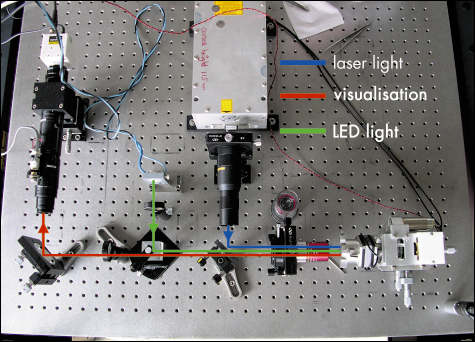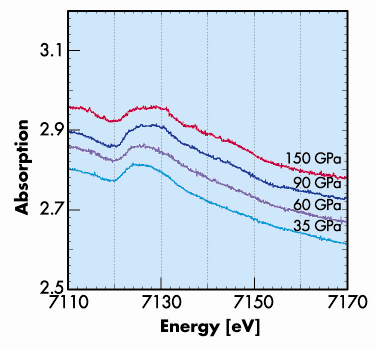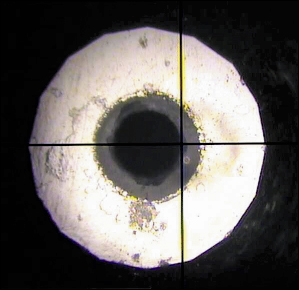- Home
- Users & Science
- Scientific Documentation
- ESRF Highlights
- ESRF Highlights 2008
- Methods and instrumentation
- Laser drilling of DAC gaskets
Laser drilling of DAC gaskets
Diamond anvil cells have been used increasingly on synchrotron X-ray beamlines over the past decade due to the pressure and temperature range they permit, and the match between available sample volume and beam size. As the availability of micrometre sized beam grows, smaller samples may be used with smaller diamond culets in order to reach higher pressures, up to and above one megabar. This means of course that the hole for the sample in the gasket which is clamped between the two diamonds also has to follow the same reduction in size. The classical method of drilling the hole in the gasket by electro-erosion becomes increasingly difficult when the hole size goes below 100 micrometres. The laser drill we have developed allows the drilling of holes with sizes ranging from 25 µm up to 1 mm with a precision of 2 µm. Additionally, in contrast to electro-erosion drilling that can only be used for metals, the laser drill can be used for materials such as ceramics, salts and even diamond.
The setup (Figure 153) uses a pulsed Nd:YVO4 laser at a wavelength of 1064 nm which was selected for its short pulse length of 10 ns. This allows more efficient ablation of the material and reduces the heat affected zone. A standard beam expander and microscope objective focus the laser beam on the gasket. The gasket is fixed on a high precision spindle which was developed in house. The first alignment stage of the spindle is for pre-alignment by means of simple screws; the second alignment stage is a rotating XY piezo mounted on the axis; the mechanical support consists of the bearing cage, motor and slip ring contacts. The combination of axis and bearing cage was designed to compensate for temperature changes; the axis is belt driven by an offset motor to minimise the mechanical noise. Special care was taken to optimise the visualisation; the constant focus zoom allows on screen images from 900 to 120 micrometres in diameter.
 |
|
Fig. 153: Setup of the laserdrill. |
The laser drill was first developed to gain time drilling micro-holes for multimegabar X-ray experiments. One of the very first experiments requiring the use of the laser drill was run in parallel on ID27 and ID24 for the study of phase transformations at the deep earth pressure and temperature conditions (Figure 154). On the high pressure beamline ID27 the samples were synthesised in situ by laser heating, using X-ray diffraction to verify the crystalline structure. In the second part of the experiment the oxidation state of iron was measured by EXAFS on the dispersive beamline ID24.
 |
|
Fig. 154: Fe K-edge XANES analysis of Al-bearing(Mg,Fe)SiO3 Perovskite and post Perovskite phases up to 1.5 Mbar (image courtesy D. Andrault). |
New applications have also become possible: the use of non metallic materials in built up gaskets (Figure 155; S. Petitgirard / ID22; V. Giordano / ID16; G. Garbarino / ID27), cutting small samples (A. Bosak / ID28). Some tests have been done on the drilling of pinholes which are to be used as beam cleaning elements. Future possibilities include drilling of multiple holes in one gasket to use multiple samples or to separate the pressure measurement ruby from the sample.
 |
|
Fig. 155: Gasket drilled / filled with NaCl / drilled to avoid contact between the molten Tellurium sample and Rhenium gasket (courtesy V. Giordano / ID16). The hole in the centre is dark, the salt is the grey ring. The bigger white ring is the imprint of the diamond, 600 micrometres in size. |
The authors would like to thank their colleagues who have made the examples available for this highlight: S. Pascarelli, V. Giordano. They also would like to thank R. Boehler of the Max Planck Institute who has built the first laser drill; P. Duboc for help with the drawings of the spindle and I. Snigireva for electron microscope work.
Authors
P. van der Linden (a), M. Mezouar (a), N. Guignot (b), Y. Dabin (a), J. Jacobs (a) and D. Gibson (a).
(a) ESRF
(b) Synchrotron Soleil (France)



